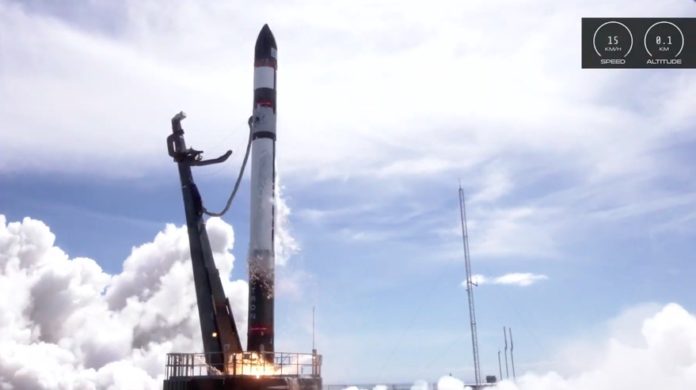
Rocket Lab, a space systems company and expert in dedicated small satellite launch, has successfully completed ‘return to sender’ launch mission. With 30 small satellites to orbit, the company has deployed the largest number of satellites by Electron to date on a single mission.
The 16th Electron mission
The efforts of the Rocketlab team have achieved a milestone in making Electron a reusable rocket as part of this ‘Return to Sender’ mission. This increases therefore launch frequency and reduces launch costs for small satellites.
With a successful splashdown and recovery of the first stage of an Electron launch vehicle for the first time, Rocketlab has brought the stage back to Earth under a parachute after launch.
Approximately two and a half minutes after lift-off, at an altitude of around 80 km, Electron’s first and second stages separated per standard mission procedure. Once the engines shut down on Electron’s first stage, a reaction control system re-oriented the stage 180-degrees to place it on an ideal angle for re-entry, enabling it to survive the incredible heat and pressure known as “The Wall” during its descent back to Earth. A drogue parachute was deployed to increase drag and to stabilize the first stage as it descended, before a large main parachute was deployed in the final kilometers of descent. The stage splashed down as planned. Rocket Lab’s recovery team will transport the stage back to Rocket Lab’s production complex, where engineers will inspect the stage to gather data that will inform future recovery missions.
Joining the satellites for the ride to orbit was a mass simulator shaped like a garden gnome, launched to space in support of Starship Children’s Hospital. Manufactured by design studio Weta Workshop for Valve’s Gabe Newell, Gnome Chompski is a 150 mm, 3D printed titanium gnome created as a nod to an achievement in the game Half-Life 2 that sees players carry a gnome through the came before depositing him in a rocket to be launched to space.
While watching Gnome Chompski get launched to space for real was a spectacle enjoyed by gamers worldwide, Mr. Chompski also served an important R&D function by allowing Rocket Lab to test and qualify novel 3D printing techniques that could be employed for future spacecraft components. Gnome Chompski’s time in space is limited though, as he remains attached to Electron’s Kick Stage and will de-orbit with it when the stage burns up on re-entry to the Earth’s atmosphere. For every person who watched the launch webcast, Mr. Newell donated a dollar to the Paediatric Intensive Care Unit at Starship Children’s Hospital.
“It’s a privilege to once again provide access to orbit for our returning customers Unseenlabs, Swarm Technologies, and TriSept, and to deploy a satellite for the University of Auckland for the very first time,” said Rocket Lab founder and CEO, Peter Beck.. “Thank you to our incredible customers, and to the tireless team behind Electron who delivered mission success once again.”
Remember, you can post free of charge job opportunities in the AM Industry on 3D ADEPT Media or look for a job via our job board. Make sure to follow us on our social networks and subscribe to our weekly newsletter : Facebook, Twitter, LinkedIn & Instagram ! If you want to be featured in the next issue of our digital magazine or if you hear a story that needs to be heard, make sure to send it to contact@3dadept.com





